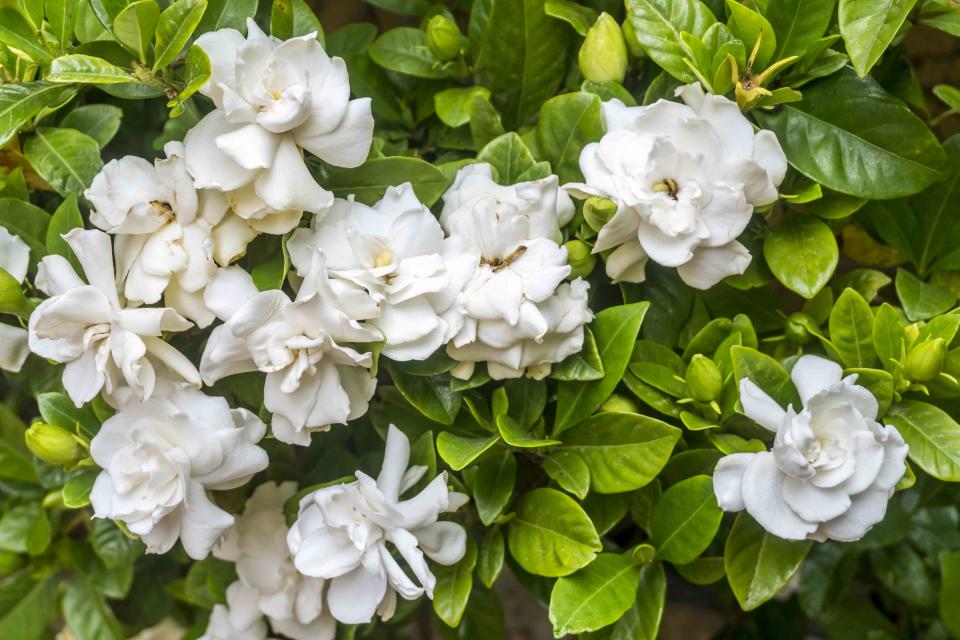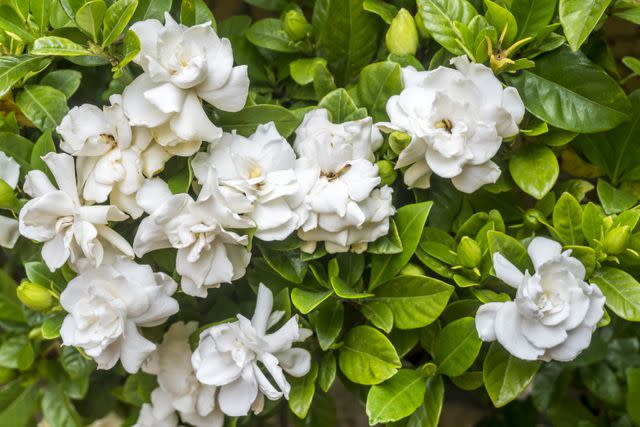How To Grow And Care For Gardenias

Enjoy beautiful blossoms throughout the summer.

Getty Images
When you list plants that belong in a classic Southern garden, the gardenia (Gardenia jasminoides) has to be at the top of the list. Beautiful evergreen leaves, snow-white blossoms, intoxicating fragrance, and the ability to withstand the Southern summer heat. What more could you ask for? Also known as cape jasmine, gardenias can bloom as early as spring and will continue to produce flowers throughout the summer and into fall.
With showy blooms that open white and fade to gold, gardenias are versatile as single shrubs or hedges and make beautiful container gardens. These double-form flowers are toxic to dogs, cats, and horses and require some specific care.
Plant Attributes
Common Name: | Common Gardenia, Cape Jasmine |
Botanical Name: | Gardenia jasminoides |
Family: | Rubiaceae |
Plant Type: | Perennial, Shrub |
Mature Size: | 3-8 ft. tall, 3-8 ft. wide |
Sun Exposure: | Partial |
Soil Type: | Moist, Well-drained, Rich |
Soil pH: | Acidic (5.0 to 6.5) |
Bloom Time: | Spring, Summer, Fall |
Flower Color: | Red, Pink, Yellow, White |
Hardiness Zones: | Zones 7-11 (USDA) |
Native Area: | Asia |
Toxicity: | toxic to dogs, toxic to cats, toxic to pets |
Gardenias Care
Gardenias are easy to grow but require a bit of attention. For gardenias to thrive, plant in an area with morning sun and afternoon shade in moist, acidic, and well-draining soil. These plants need good air circulation and proper fertilization to make them happy. With lustrous leaves, beautiful flowers, and a heavenly fragrance, gardenias are the perfect plants to grace summer days.
While gardenias make beautiful additions to borders, they prefer avoiding other plants or competing roots. Place gardenias along pathways, at the corners of your house, or near windows where you can appreciate them even from inside your home. Gardenias do well in large pots on decks and patios—which are the perfect spot to place them to take full advantage of their beautiful blooms and fragrance. Let potted plants grow naturally or clip and train them as topiary standards. Unfortunately, they make poor houseplants and attract mites, mealybugs, and whiteflies.
Light
Gardenias like a lot of sunshine, but it is essential to have them in a place protected from the afternoon sun, especially in the hotter months of summer. Too much sun could result in the leaves becoming scored and the plant dying. North and east-facing exposures are ideal because the plants will receive bright morning light and some midday sun but won't be in full sun during the hottest part of the day.
Soil
Gardenias prefer soil that is acidic, moist, and well-draining. Adding organic matter to the soil will help your gardenia thrive all season.
Water
Gardenias need at least an inch of water weekly through watering or rainfall. Water the base of the plant to avoid fungal spots from developing on wet leaves—watering in the morning also helps. Keep the soil damp, never soggy, and don't let it completely dry out. Overwatering or underwatering your gardenia could cause the flower buds not to open or even fall off. Reduce watering throughout the winter for potted plants and add a layer of mulch to protect the roots.
Temperature and Humidity
Gardenias need high humidity and temperatures above 60°F to flourish. Provide extra moisture to your gardenia by misting daily, using a humidifier, or placing the plant on a tray of moist pebbles. Providing this humidity will ward off spider mites who take over gardenias in dry conditions.
Fertilizer
Gardenias respond well to fertilizer. Add an acidic, slow-release fertilizer for showy blooms every two to four weeks during the growing season, which lasts from March to October. To avoid over-fertilization, dilute the fertilizer with water or mix it into the soil. Stop fertilization before the first frost. Add a blood meal, fish emulsion, or bone meal supplement to the soil for an organic option.
Types of Gardenias
Gardenias are available in several varieties and cultivars, some growing better in specific climates. Some gardenias are more cold-tolerant, so check before planting in areas that experience fluctuating temperatures. Here are some gardenia options to know:
Gardenia jasminoides 'Radicans': An ideal plant to train as a bonsai because of its small leaves and size. The spreading evergreen shrub has fragrant double blooms.
Gardenia thunbergia: A large shrub variety, this plant has twig-like, smooth branches and showy cream-colored blooms.
Gardenia jasminoides' August Beauty': A large, double flower variety featuring three-inch wide blooms in early summer. In addition to showy blooms, this cold-hardy variety has glossy foliage.
Gardenia jasminoides 'Mystery': This variety has four-to-five-inch white flowers that fade to a cream-yellow hue.
Pruning
Prune young gardenias to achieve the desired shape. Established plants need pruning about two-thirds of the way to the ground after flowering. Continue pruning by removing dead or diseased branches with scissors or garden shears. Deadhead flowers as new buds form on new and old wood, encouraging new growth.

Getty Images
Propagating Gardenias
Stem cutting is the best way to propagate gardenias. Use cuttings taken from pruning or stem cuttings taken in early spring to grow new plants. Depending on the gardenia variety, some plants are trademarked or from patented cultivars, which means you are not allowed to propagate. For other selections, here is how to propagate gardenias through stem cuttings:
Use a sharp knife or pruning shears to cut at an angle below the leaf node—preferably on green wood—on a branch at least four inches long. Remove the lower leaves.
Dip the stem in a rooting hormone if preferred.
Fill a container with a mix of moist perlite and potting soil. Use your finger or a pencil to make holes in the mixture.
Plant the stem cuttings in each hole and gently pack the soil around the branch.
Use a plastic bag to cover the entire container and encourage humidity. Use garden stakes to help secure the bag over the plant.
Place the container in a warm location—at least 75°F—for four to eight weeks. Continue to keep the soil moist.
After roots establish, transplant gardenias into a larger container. Continue growing indoors or outside, weather permitting.
How to Grow Gardenias From Seed
It is possible to grow gardenias from seeds, but it is challenging and time-consuming. Gardenias can take at least two to three years before flowering. In early winter, fill a seed-starting tray or container with potting soil or a mixture containing peat moss and perlite. Using seeds from a garden center or cleaning and collecting from seed pods, plant the gardenia seeds in the container, barely covering them with soil. If using seed pods, place the seeds near a sunny window and dry them on a paper towel for three to four weeks before planting.
After planting seeds, keep the container moist and warm, but not directly in sunlight. Seeds should germinate within four to six weeks. After the seedlings reach a few inches tall, the gardenias are ready to transplant into a new container.
Potting and Repotting Gardenias
After establishing roots, gardenias prefer to avoid repotting. The best times to plant gardenias are fall and spring when temperatures are moderate. If potting or repotting a gardenia is required, dig a hole twice as wide and just as deep as the plant's root ball.
The soil should drain quickly but retain water—condition it with organic matter such as peat moss or ground bark. Firmly pack three to four inches of soil at the bottom of the hole and set the root ball about one inch higher than the surrounding soil to help ensure adequate drainage. Then, gently taper the soil to the top of the exposed root ball. Mulch plants with pine straw or chopped leaves. Hand-pull weeds instead of cultivating around the root zone since gardenias do not like to be disturbed once established.
Overwintering
Gardenias need protection from the cold weather. These flowers will not survive below 60°F. During fluctuating temperatures, gardenias will not flower as frequently or vigorously when exposed to varying climates. Since gardenias do not go fully dormant, indoor care conditions must mimic outdoor conditions. Keep plants near a sunny window, receiving at least four to six hours of sunlight daily. Supplement the air circulation with a humidifier and occasionally misting plant. Watering might decrease in winter, but don't let the soil dry completely. Add a slow-release fertilizer and organic mulch to help retain plant health and moist soil.
Common Pests & Plant Diseases
Gardenias are susceptible to several pests, especially when lacking proper care. Aphids, scales, mealy bugs, spider mites, and white flies impact gardenias but are treatable with horticultural oil. Be sure to spray down outdoor plants before bringing them inside.
Diseases also impact gardenias, especially powdery mildew, root rot, stem canker, and leaf spot. Fungicides help treat some of these conditions but maintaining proper watering, healthy soil, and balanced sun exposure is the best way to avoid these diseases.
How to Get Gardenias to Bloom
Gardenias are known for their showy blooms. There are several ways to achieve better flowering. Use fertilizer to promote new flowers, especially during the growing season or if the foliage is yellowing. Additionally, maintain warm temperatures, high humidity, and moist soil. Gardenias need pruning in early summer after it finishes blooming, so you don't remove the flower buds that emerge in late summer or fall, as this is next year's growth. Removing spent flowers helps maintain the plant's appearance.
Common Problems With Gardenias
Gardenias need specific care conditions met for these flowers to thrive. Here are some issues gardeners might experience when growing gardenias and how to resolve them:
Leaves Turning Yellow
Gardenias develop yellow leaves in poor sunlight, inappropriate climates, and when soil lacks nutrients. Diseases like root rot and powdery mildew cause foliage to turn yellow—usually the oldest leaves first. While yellowing leaves are expected in early spring before new growth appears, it is abnormal and indicates something wrong during other times of the year.
Curling Or Drooping Leaves
Diseases like stem canker or the presence of nematodes cause leaves to curl or wilt and eventually drop. Stem canker is often found near the plant's stems but can also impact the roots. This fungus spreads quickly, so removing infected branches can help stop it from ruining the entire plant. Sterilize pruning shears before cutting and avoid over-or-under-fertilizing plants. Test the soil for nematodes and replant gardenias in a new location if present.
Frequently Asked Questions
Are gardenias indoor or outdoor plants?
Gardenias grow well as houseplants or outdoors. If provided a choice, growing gardenias outside in direct or partial sunlight in a moist soil garden is best.
Can gardenia be left outside in winter?
Gardenias only tolerate temperatures down to 20°F. Exposure to temperatures 15°F or lower will cause cold damage. Some cold exposure is tolerable, and gardenias can recover if moved to an area with moderate temperatures, preferably between 60°F and 70°F.
For more Southern Living news, make sure to sign up for our newsletter!
Read the original article on Southern Living.